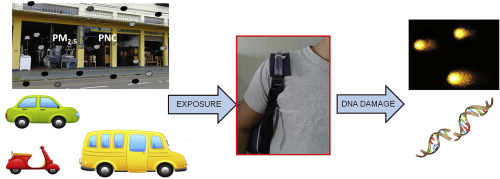当前位置:
X-MOL 学术
›
Atmos. Environ.
›
论文详情
Our official English website, www.x-mol.net, welcomes your
feedback! (Note: you will need to create a separate account there.)
Genotoxic effects of daily personal exposure to particle mass and number concentrations on buccal cells
Atmospheric Environment ( IF 4.2 ) Pub Date : 2018-03-01 , DOI: 10.1016/j.atmosenv.2017.12.021 Daniela S. de Almeida , Silvano César da Costa , Marcos Ribeiro , Camila A.B. Moreira , Alexandra Beal , Rafaela Squizzato , Anderson Paulo Rudke , Sameh Adib Abou Rafee , Jorge A. Martins , Graciana Freitas Palioto , Prashant Kumar , Leila D. Martins
Atmospheric Environment ( IF 4.2 ) Pub Date : 2018-03-01 , DOI: 10.1016/j.atmosenv.2017.12.021 Daniela S. de Almeida , Silvano César da Costa , Marcos Ribeiro , Camila A.B. Moreira , Alexandra Beal , Rafaela Squizzato , Anderson Paulo Rudke , Sameh Adib Abou Rafee , Jorge A. Martins , Graciana Freitas Palioto , Prashant Kumar , Leila D. Martins

|
Abstract The aim of this study is to assess personal exposure to Particle Number Concentrations (PNC) in four size ranges between 0.3 and 10 μm, and particulate matter (PM1; PM2.5; PM4; PM10) in order to evaluate possible genotoxic effects through a comet assay in buccal cells. A convenience cohort of 30 individuals from a Brazilian medium-sized city was selected. These individuals aged between 20 and 61 and worked in typical job categories (i.e., administrative, commerce, education, general services and transport). They were recruited to perform personal exposure measurements during their typical daily routine activities, totaling 240 h of sampling. The 8-h average mass concentrations in air for volunteers ranged from 2.4 to 31.8 μg m−3 for PM1, 4.2–45.1 μg m−3 for PM2.5, 7.9–66.1 μg m−3 for PM4 and from 23.1 to 131.7 μg m−3 for PM10. The highest PNC variation was found for 0.3–0.5 range, between 14 and 181 particles cm−3, 1 to 14 particles cm−3 for the 0.5–1.0 range, 0.2 to 2 particles cm−3 for the 1.0–2.5 range, and 0.06 to 0.7 particles cm−3 for the 2.5–10 range. Volunteers in the ‘education’ category experienced the lowest inhaled dose of PM2.5, as opposed to those involved in ‘commercial‘ activities with the highest doses for PM10 (1.63 μg kg−1 h−1) and PM2.5 (0.61 μg kg−1 h−1). The predominant cause for these high doses was associated with the proximity of the workplace to the street and vehicle traffic. The comet assay performed in buccal cells indicated that the volunteers in ‘commerce’ category experienced the highest damage to their DeoxyriboNucleic Acid (DNA) compared with the control category (i.e. ‘education’). These results indicate the variability in personal exposure of the volunteers in different groups, and the potential damage to DNA was much higher for those spending time in close proximity to the vehicle sources (e.g. commercial services) leading to exposure to a higher fraction of fine particles. This study builds understanding on the exposure of people in different job categories, and provide policy makers with useful information to tackle this neglected issue.
中文翻译:

个人每日暴露于颗粒质量和数量浓度对口腔细胞的遗传毒性影响
摘要 本研究的目的是评估个人暴露于 0.3 至 10 μm 之间四种粒径范围内的粒子数浓度 (PNC) 和颗粒物 (PM1; PM2.5; PM4; PM10) 以评估可能的遗传毒性影响。颊细胞中的彗星试验。选择了来自巴西中等城市的 30 人的便利队列。这些人年龄在 20 至 61 岁之间,从事典型的工作类别(即行政、商业、教育、一般服务和运输)。他们被招募在他们典型的日常活动中进行个人暴露测量,总共采样 240 小时。志愿者在空气中的 8 小时平均质量浓度范围为 PM1 2.4 至 31.8 μg m-3、PM2.5 4.2-45.1 μg m-3、PM4 7.9-66.1 μg m-3 和 23.1 至 131.7 μg对于 PM10,m-3。在 0.3-0.5 范围内发现了最高的 PNC 变化,14 到 181 个粒子 cm-3 之间,0.5-1.0 范围内为 1 到 14 个粒子 cm-3,1.0-2.5 范围内为 0.2 到 2 个粒子 cm-3,以及0.06 到 0.7 个粒子 cm-3,范围为 2.5-10。“教育”类别的志愿者吸入的 PM2.5 剂量最低,而参与“商业”活动的志愿者吸入的 PM10 剂量最高(1.63 μg kg-1 h-1)和 PM2.5(0.61 μg) kg-1 h-1)。这些高剂量的主要原因与工作场所靠近街道和车辆交通有关。在口腔细胞中进行的彗星试验表明,与对照类别(即“教育”)相比,“商业”类别的志愿者对其脱氧核糖核酸 (DNA) 的损伤最大。这些结果表明,不同组别的志愿者的个人暴露情况存在差异,对于那些花时间靠近车辆来源(例如商业服务)的人来说,对 DNA 的潜在损害要高得多,从而导致暴露于更高比例的细颗粒. 这项研究加深了人们对从事不同工作类别的风险的了解,并为政策制定者提供了有用的信息来解决这个被忽视的问题。
更新日期:2018-03-01
中文翻译:

个人每日暴露于颗粒质量和数量浓度对口腔细胞的遗传毒性影响
摘要 本研究的目的是评估个人暴露于 0.3 至 10 μm 之间四种粒径范围内的粒子数浓度 (PNC) 和颗粒物 (PM1; PM2.5; PM4; PM10) 以评估可能的遗传毒性影响。颊细胞中的彗星试验。选择了来自巴西中等城市的 30 人的便利队列。这些人年龄在 20 至 61 岁之间,从事典型的工作类别(即行政、商业、教育、一般服务和运输)。他们被招募在他们典型的日常活动中进行个人暴露测量,总共采样 240 小时。志愿者在空气中的 8 小时平均质量浓度范围为 PM1 2.4 至 31.8 μg m-3、PM2.5 4.2-45.1 μg m-3、PM4 7.9-66.1 μg m-3 和 23.1 至 131.7 μg对于 PM10,m-3。在 0.3-0.5 范围内发现了最高的 PNC 变化,14 到 181 个粒子 cm-3 之间,0.5-1.0 范围内为 1 到 14 个粒子 cm-3,1.0-2.5 范围内为 0.2 到 2 个粒子 cm-3,以及0.06 到 0.7 个粒子 cm-3,范围为 2.5-10。“教育”类别的志愿者吸入的 PM2.5 剂量最低,而参与“商业”活动的志愿者吸入的 PM10 剂量最高(1.63 μg kg-1 h-1)和 PM2.5(0.61 μg) kg-1 h-1)。这些高剂量的主要原因与工作场所靠近街道和车辆交通有关。在口腔细胞中进行的彗星试验表明,与对照类别(即“教育”)相比,“商业”类别的志愿者对其脱氧核糖核酸 (DNA) 的损伤最大。这些结果表明,不同组别的志愿者的个人暴露情况存在差异,对于那些花时间靠近车辆来源(例如商业服务)的人来说,对 DNA 的潜在损害要高得多,从而导致暴露于更高比例的细颗粒. 这项研究加深了人们对从事不同工作类别的风险的了解,并为政策制定者提供了有用的信息来解决这个被忽视的问题。











































 京公网安备 11010802027423号
京公网安备 11010802027423号